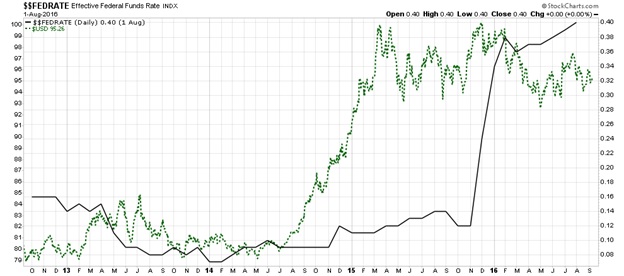A number of officials from the central bank have already suggested that two rate rises are possible this year, and now economists and investors assessing the economic data are also leaning in favor of two hikes. The quid pro quo for rising interest rates is a strengthening US Dollar Index and if that does indeed happen then it would really hammer Wall Street equities – especially high-yielding dividend stocks.
this year, and now economists and investors assessing the economic data are also leaning in favor of two hikes. The quid pro quo for rising interest rates is a strengthening US Dollar Index and if that does indeed happen then it would really hammer Wall Street equities – especially high-yielding dividend stocks.
The comments above and below are excerpts from an article by I.M. Vronsky (gold-eagle.com) which have been enhanced – edited ([ ]) and abridged (…) – by munKNEE.com (Your Key to Making Money!)
to provide you with a faster & easier read.
- San Francisco Fed President John Williams has said his preference would be for two rate hikes before the end of the year, echoing comments he made in June.
- Fed governor Jerome Powell has also said he was prepared to raise interest rates twice this year in September and December as long the economy continues to perform as expected…
- Senior foreign exchange strategist at ANZ, Khoon Goh, told CNBC; “My base case is they hike in September, with two hikes before the end of the year. The market is not really fully priced for that, so a hike in September will be dollar positive. I think for September, the market is only about 10 basis points priced in, meaning a large portion of the market are not positioned expecting an interest rate rise, which could push the dollar index against a basket of currencies above the 100 level, up from its current levels of 96.5.”

Without question the Fed is slowly and methodically raising the Fed Funds Rate [as can be seen in the graph below,] which is driving the US greenback higher. Moreover, we may count on this hawkish Fed policy to continue for the foreseeable future…[as] Fed Chair Yellen… “orchestrates” her future legacy.
…As the Fed Funds Rate increases, thus fueling higher levels of short-term US Treasury Yields, the US Dollar Index will continue to rise with a possible price objective of 120 sometime in the near future. As history is testament, the quid pro quo for rising interest rates is a strengthening US Dollar Index.
Conclusions
In the event interest rates continue to swing higher (as the above analysis indicates), it would really hammer Wall Street equities – especially high-yielding dividend stocks.
- The 2009-2016 bull market in stocks is possibly one of the longest in financial history [and,] to be sure, ALL bull markets eventually and inevitably end – and are usually followed by substantial corrections:
- The 2000-2002 Bear Market saw the Dow Index drop approximately 40%
- the 2007-2009 Bear Market slammed the Dow Index down 54%.
To be sure, a new Bear Market in stocks might see the Dow suffer an egregious loss by plunging down to retest its March 2009 low at 6500 [which] is a plausible forecast…[given that] the price earnings ratio of the S&P 500 Index is at 25:1 today which is higher than it was in October, 1929, just before the horrific crash that hammered stocks down 89% during the following three years.
“Follow the munKNEE” – Your Key to Making Money! “Like” this article on Facebook; have your say on Twitter; register to receive our bi-weekly Market Intelligence Report newsletter (see sample here , sign up in top right hand corner)
 munKNEE.com Your Key to Making Money
munKNEE.com Your Key to Making Money